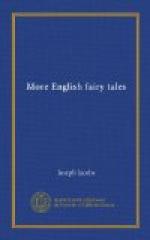LXVII. A SON OF ADAM
Source.—From memory, by Mr. E. Sidney Hartland, as heard by him from his nurse in childhood.
Parallels.—Jacques de Vitry Exempla, ed. Prof. Crane, No. xiii., and references given in notes, p. 139. It occurs in Swift and in modern Italian folk-lore.
Remarks.—The Exempla were anecdotes, witty and otherwise, used by the monks in their sermons to season their discourse. Often they must have been derived from the folk of the period, and at first sight it might seem that we had found still extant among the folk the story that had been the original of Jacques de Vitry’s Exemplum. But the theological basis of the story shows clearly that it was originally a monkish invention and came thence among the folk.
LXVIII. THE CHILDREN IN THE WOOD
Source.—Percy, Reliques. The ballad form of the story has become such a nursery classic that I had not the heart to “prose” it. As Mr. Allingham remarks, it is the best of the ballads of the pedestrian order.
Parallels.—The second of R. Yarrington’s Two Lamentable Tragedies, 1601, has the same plot as the ballad. Several chap-books have been made out of it, some of them enumerated by Halliwell’s Popular Histories (Percy Soc.) No. 18. From one of these I am in the fortunate position of giving the names of the dramatis personae of this domestic tragedy. Androgus was the wicked uncle, Pisaurus his brother who married Eugenia, and their children in the wood were Cassander and little Kate. The ruffians were appropriately named Rawbones and Woudkill. According to a writer in 3 Notes and Queries, ix., 144, the traditional burial-place of the children is pointed out in Norfolk. The ballad was known before Percy, as it is mentioned in the Spectator, Nos. 80 and 179.
Remarks.—The only “fairy” touch—but what a touch!—the pall of leaves collected by the robins.
LXIX. THE HOBYAHS
Source.—American Folk-Lore Journal, iii., 173, contributed by Mr. S.V. Proudfit as current in a family deriving from Perth.
Remarks.—But for the assurance of the tale itself that Hobyahs are no more, Mr. Batten’s portraits of them would have convinced me that they were the bogles or spirits of the comma bacillus. Mr. Proudfit remarks that the cry “Look me” was very impressive.
LXX. A POTTLE O’ BRAINS
Source.—Contributed by Mrs. Balfour to Folk-Lore, II.
Parallels.—The fool’s wife is clearly related to the Clever Lass of “Gobborn Seer,” where see Notes.
Remarks.—The fool is obviously of the same family as he of the “Coat o’ Clay” (No. lix.) if he is not actually identical with him. His adventures might be regarded as a sequel to the former ones. The Noodle family is strongly represented in English folk-tales, which would seem to confirm Carlyle’s celebrated statistical remark.




